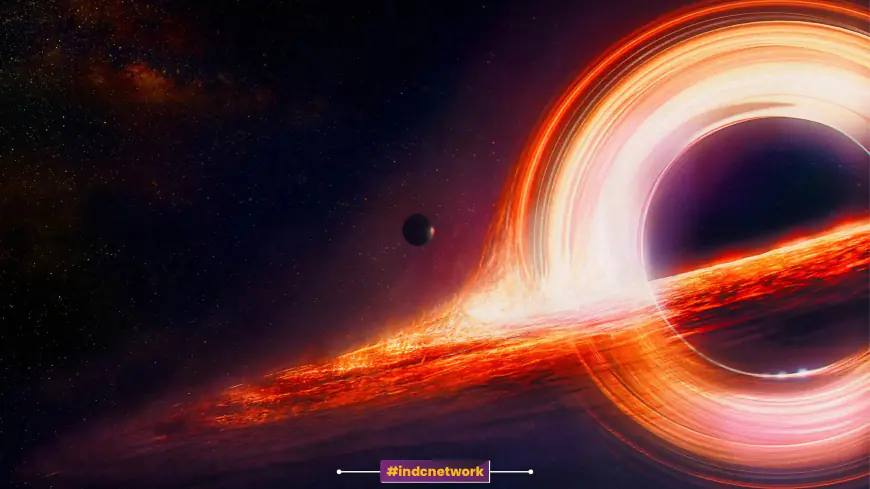The Physics of Black Holes : Unraveling the Mysteries of the Universe
Black holes, once a purely theoretical construct, are now one of the most fascinating and mysterious objects in the universe. This article explores the physics behind black holes, their formation, properties, types, and their role in cosmic events. It delves into the complexities of singularities, event horizons, Hawking radiation, and how black holes shape our understanding of space and time. From general relativity to quantum mechanics, the study of black holes offers profound insights into the fundamental nature of reality.

INDC Network : Science : The Physics of Black Holes: Unraveling the Mysteries of the Universe
Introduction: The Enigmatic World of Black Holes
Black holes are among the most enigmatic and intriguing phenomena in the universe. Initially predicted by Albert Einstein’s theory of general relativity, black holes have since become a central topic in astrophysics and theoretical physics. These celestial objects are regions of space where gravity is so intense that nothing, not even light, can escape. The study of black holes opens windows into the deepest laws of nature, connecting general relativity and quantum mechanics, two seemingly incompatible realms of physics.
Despite their mysterious nature, black holes are now widely accepted as real, observable entities, thanks to technological advancements like gravitational wave detectors and the Event Horizon Telescope. This article explores the formation, structure, and behavior of black holes, addressing key concepts such as singularities, event horizons, and Hawking radiation, as well as the profound implications black holes have for our understanding of the universe.
The Formation of Black Holes: Death of a Star
Black holes form primarily when massive stars reach the end of their life cycle. After millions or billions of years of nuclear fusion, a star exhausts its fuel, causing the core to collapse under its own gravity. If the remaining mass is more than about three times that of the Sun, the gravitational collapse will continue to the point where no force can stop it, leading to the formation of a black hole.
This process often occurs in stages:
-
Stellar Collapse: When a star depletes its nuclear fuel, the pressure that counteracts gravity diminishes, causing the star to collapse. In stars more massive than three solar masses, the collapse is so extreme that it leads to the formation of a black hole.
-
Supernova: For massive stars, this collapse triggers a supernova explosion, ejecting outer layers of the star into space. The remaining core may become a neutron star or continue collapsing into a black hole.
-
Formation of the Event Horizon: As the star's core continues collapsing, it reaches a critical radius known as the Schwarzschild radius, where the escape velocity exceeds the speed of light. This forms the black hole's event horizon, the boundary beyond which nothing can escape.
Event Horizon: The Point of No Return
The event horizon is a critical concept in the physics of black holes. It represents the boundary of the black hole, beyond which nothing, not even light, can escape the gravitational pull. The Schwarzschild radius is the distance from the center of the black hole to the event horizon, which depends on the mass of the black hole. For a black hole with the mass of the Sun, this radius is about 3 kilometers.
The event horizon itself is not a physical surface; it is a theoretical boundary that marks the region where escape is impossible. As an object approaches the event horizon, the gravitational force increases dramatically, causing time to slow down relative to an outside observer. This phenomenon, predicted by Einstein’s theory of relativity, is known as gravitational time dilation.
For an observer falling into a black hole, time appears to pass normally, but from an external viewpoint, the object seems to freeze at the event horizon, never fully disappearing from sight. This time distortion is one of the key features of black holes that baffle and intrigue physicists.
Singularity: The Heart of the Black Hole
At the very center of a black hole lies the singularity, a point of infinite density where space and time break down. The laws of physics as we currently understand them cease to function at the singularity. According to general relativity, the gravitational field becomes infinitely strong, and the curvature of spacetime becomes infinite.
The singularity is one of the most perplexing aspects of black holes because it represents a region where the known laws of physics cannot be applied. At the singularity, the force of gravity becomes so intense that spacetime itself is stretched to infinity, leading to an inescapable paradox in our understanding of nature.
Physicists believe that a theory of quantum gravity, which combines general relativity and quantum mechanics, is needed to fully understand the singularity. However, such a theory remains elusive, leaving the singularity as one of the greatest mysteries in science.
Types of Black Holes
Black holes come in several varieties, classified mainly by their mass:
-
Stellar Black Holes: These black holes form from the collapse of massive stars and have masses ranging from a few to several tens of solar masses. They are the most common type of black hole.
-
Supermassive Black Holes: Found at the centers of galaxies, including our own Milky Way, these black holes contain millions or even billions of times the mass of the Sun. The origin of supermassive black holes is still a topic of active research, but they are believed to form through the merging of smaller black holes or the accretion of vast amounts of matter.
-
Intermediate-Mass Black Holes: These black holes are rarer and have masses between stellar and supermassive black holes, in the range of hundreds to thousands of solar masses. Their existence was confirmed relatively recently, and they may form through the merger of smaller black holes.
-
Primordial Black Holes: Hypothetical black holes that may have formed in the early universe, shortly after the Big Bang. These black holes could be much smaller than stellar black holes and might provide insights into the nature of dark matter.
Hawking Radiation: Black Holes Aren’t Forever
One of the most groundbreaking theoretical predictions about black holes came from Stephen Hawking in 1974. He proposed that black holes are not completely black; they emit radiation due to quantum effects near the event horizon. This phenomenon, now known as Hawking radiation, arises because of quantum fluctuations in the vacuum of space. These fluctuations can cause particle-antiparticle pairs to form near the event horizon. If one particle falls into the black hole while the other escapes, the black hole loses a small amount of mass.
Over long periods, this process causes black holes to slowly evaporate and eventually disappear. However, for a black hole with the mass of the Sun, this would take far longer than the current age of the universe, so Hawking radiation remains a theoretical concept for now. Nevertheless, it introduced a profound connection between quantum mechanics and general relativity, two of the most important theories in physics.
Black Holes and Information Paradox
One of the most debated topics in black hole physics is the black hole information paradox. According to quantum mechanics, information about the state of a system cannot be destroyed. However, if something falls into a black hole, it seems that all information about it is lost forever. This conflicts with quantum theory, leading to a paradox.
Hawking initially argued that information could indeed be lost, but later research suggests that the information might be preserved in some way, perhaps encoded in the Hawking radiation itself or stored on the event horizon. This problem remains unresolved and continues to be a major area of research in theoretical physics.
The Role of Black Holes in the Universe
Black holes are not just isolated objects floating in space. They play a crucial role in shaping the structure and evolution of galaxies and, more broadly, the universe.
-
Supermassive Black Holes and Galaxy Formation: Almost every galaxy in the universe, including the Milky Way, contains a supermassive black hole at its center. These black holes are thought to play a role in the formation and evolution of galaxies. The relationship between the mass of the black hole and the properties of its host galaxy suggests that black holes may regulate star formation and galactic growth.
-
Gravitational Waves: The merger of two black holes generates ripples in spacetime known as gravitational waves, which were first directly detected by LIGO (Laser Interferometer Gravitational-Wave Observatory) in 2015. These waves carry information about the properties of the merging black holes and have opened up a new way of observing the universe.
-
Accretion Disks and Quasars: When black holes accrete matter from their surroundings, the material forms an accretion disk that spirals in toward the event horizon. As the material heats up, it emits radiation, sometimes outshining the entire galaxy. Supermassive black holes that power these bright emissions are known as quasars, and they can provide insights into the early universe.
Conclusion: Black Holes and the Future of Physics : The study of black holes is at the frontier of modern physics, bridging the gap between general relativity and quantum mechanics. From their formation in the death throes of massive stars to their role as cosmic engines powering quasars and merging to produce gravitational waves, black holes are integral to our understanding of the universe. Despite significant progress, many mysteries remain, particularly regarding the nature of singularities and the information paradox.
Black holes challenge our understanding of space, time, and reality itself. As technology improves and new observations are made, such as the first image of a black hole's event horizon by the Event Horizon Telescope in 2019, we move closer to uncovering the fundamental truths about these mysterious objects. The future promises exciting breakthroughs that may one day unify the forces of nature and provide a complete theory of everything, with black holes at the heart of this grand endeavor.
What's Your Reaction?













































































































































































